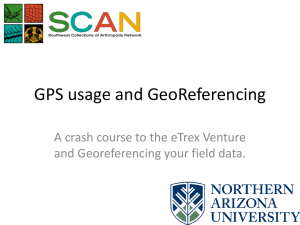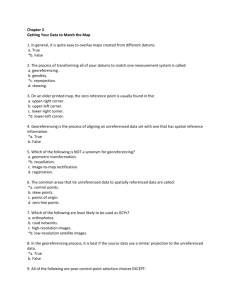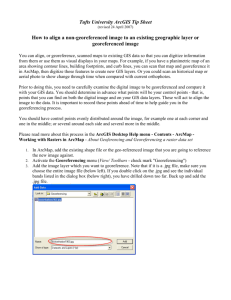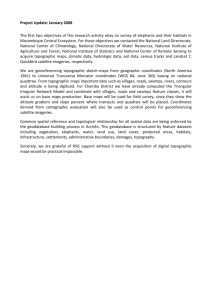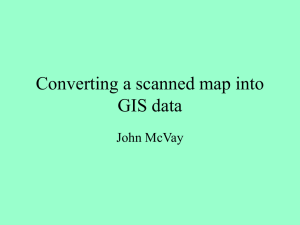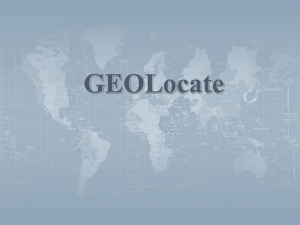COMPARISON OF TECHNIQUES FOR TERRESTRIAL LASER SCANNING DATA
advertisement
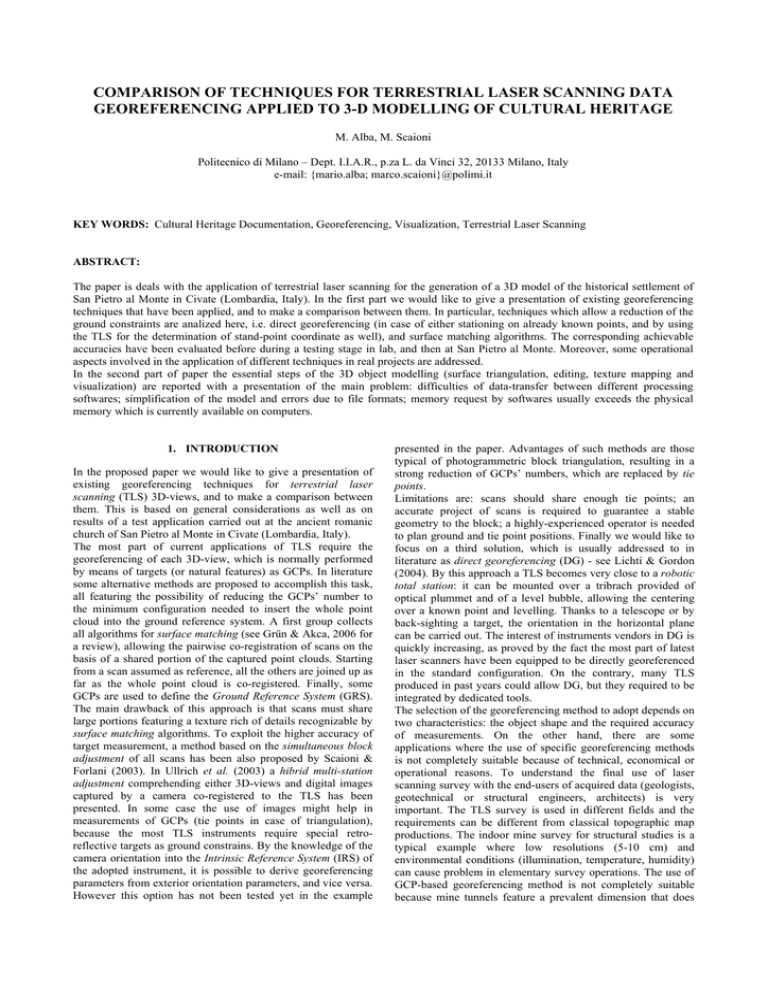
COMPARISON OF TECHNIQUES FOR TERRESTRIAL LASER SCANNING DATA
GEOREFERENCING APPLIED TO 3-D MODELLING OF CULTURAL HERITAGE
M. Alba, M. Scaioni
Politecnico di Milano – Dept. I.I.A.R., p.za L. da Vinci 32, 20133 Milano, Italy
e-mail: {mario.alba; marco.scaioni}@polimi.it
KEY WORDS: Cultural Heritage Documentation, Georeferencing, Visualization, Terrestrial Laser Scanning
ABSTRACT:
The paper is deals with the application of terrestrial laser scanning for the generation of a 3D model of the historical settlement of
San Pietro al Monte in Civate (Lombardia, Italy). In the first part we would like to give a presentation of existing georeferencing
techniques that have been applied, and to make a comparison between them. In particular, techniques which allow a reduction of the
ground constraints are analized here, i.e. direct georeferencing (in case of either stationing on already known points, and by using
the TLS for the determination of stand-point coordinate as well), and surface matching algorithms. The corresponding achievable
accuracies have been evaluated before during a testing stage in lab, and then at San Pietro al Monte. Moreover, some operational
aspects involved in the application of different techniques in real projects are addressed.
In the second part of paper the essential steps of the 3D object modelling (surface triangulation, editing, texture mapping and
visualization) are reported with a presentation of the main problem: difficulties of data-transfer between different processing
softwares; simplification of the model and errors due to file formats; memory request by softwares usually exceeds the physical
memory which is currently available on computers.
1. INTRODUCTION
In the proposed paper we would like to give a presentation of
existing georeferencing techniques for terrestrial laser
scanning (TLS) 3D-views, and to make a comparison between
them. This is based on general considerations as well as on
results of a test application carried out at the ancient romanic
church of San Pietro al Monte in Civate (Lombardia, Italy).
The most part of current applications of TLS require the
georeferencing of each 3D-view, which is normally performed
by means of targets (or natural features) as GCPs. In literature
some alternative methods are proposed to accomplish this task,
all featuring the possibility of reducing the GCPs’ number to
the minimum configuration needed to insert the whole point
cloud into the ground reference system. A first group collects
all algorithms for surface matching (see Grün & Akca, 2006 for
a review), allowing the pairwise co-registration of scans on the
basis of a shared portion of the captured point clouds. Starting
from a scan assumed as reference, all the others are joined up as
far as the whole point cloud is co-registered. Finally, some
GCPs are used to define the Ground Reference System (GRS).
The main drawback of this approach is that scans must share
large portions featuring a texture rich of details recognizable by
surface matching algorithms. To exploit the higher accuracy of
target measurement, a method based on the simultaneous block
adjustment of all scans has been also proposed by Scaioni &
Forlani (2003). In Ullrich et al. (2003) a hibrid multi-station
adjustment comprehending either 3D-views and digital images
captured by a camera co-registered to the TLS has been
presented. In some case the use of images might help in
measurements of GCPs (tie points in case of triangulation),
because the most TLS instruments require special retroreflective targets as ground constrains. By the knowledge of the
camera orientation into the Intrinsic Reference System (IRS) of
the adopted instrument, it is possible to derive georeferencing
parameters from exterior orientation parameters, and vice versa.
However this option has not been tested yet in the example
presented in the paper. Advantages of such methods are those
typical of photogrammetric block triangulation, resulting in a
strong reduction of GCPs’ numbers, which are replaced by tie
points.
Limitations are: scans should share enough tie points; an
accurate project of scans is required to guarantee a stable
geometry to the block; a highly-experienced operator is needed
to plan ground and tie point positions. Finally we would like to
focus on a third solution, which is usually addressed to in
literature as direct georeferencing (DG) - see Lichti & Gordon
(2004). By this approach a TLS becomes very close to a robotic
total station: it can be mounted over a tribrach provided of
optical plummet and of a level bubble, allowing the centering
over a known point and levelling. Thanks to a telescope or by
back-sighting a target, the orientation in the horizontal plane
can be carried out. The interest of instruments vendors in DG is
quickly increasing, as proved by the fact the most part of latest
laser scanners have been equipped to be directly georeferenced
in the standard configuration. On the contrary, many TLS
produced in past years could allow DG, but they required to be
integrated by dedicated tools.
The selection of the georeferencing method to adopt depends on
two characteristics: the object shape and the required accuracy
of measurements. On the other hand, there are some
applications where the use of specific georeferencing methods
is not completely suitable because of technical, economical or
operational reasons. To understand the final use of laser
scanning survey with the end-users of acquired data (geologists,
geotechnical or structural engineers, architects) is very
important. The TLS survey is used in different fields and the
requirements can be different from classical topographic map
productions. The indoor mine survey for structural studies is a
typical example where low resolutions (5-10 cm) and
environmental conditions (illumination, temperature, humidity)
can cause problem in elementary survey operations. The use of
GCP-based georeferencing method is not completely suitable
because mine tunnels feature a prevalent dimension that does
not allow to establish a stable set of GCPs, and where the large
overlap needed between adjacent scans would make too
expensive the use of surface matching techniques. In this case
the use of DG is highly suitable to be successfully applied (see
Alba et al., 2006 for more information). Also in other fields, as
in Cultural Heritage Documentation, the selection of the most
suitable georeferencing method allows to obtain valid results as
well as to shorten the time needed by the data processing stage.
In the application described in this paper, i.e. the survey of the
Basilica of San Pietro al Monte in Civate to achieve a 3D model
for VR visualization, two different orders of accuracy are
required. Outside the church, the simple geometric shapes and
the absence of complex artefacts call for an accuracy of about
±5 cm, enabling the use of different georeferencing methods.
On the others hand, the indoor of the Basilica presents a lot of
frescos and bas-reliefs, requiring a higher accuracy that can be
achieved only by the GCP-based approach.
In this paper we would make a comparison finalized to define
the achievable accuracy in 3D point measurement according to
different existing georeferencing techniques, firstly by a
laboratory test, and finally by using as case study the surveying
of the Basilica of San Pietro al Monte.
Figure 1: View of the basilica of San Pietro al Monte in Civate (Lomardia, Italy), and the Oratory of San Benedetto.
2. BACKGROUND ON 3D-VIEW GEOREFERENCING
The problem of scan registration is usually addressed through
the definition of 2 reference systems (RS): the intrinsic and the
ground RS.
Usually a laser scanner performs the measurement of a large
point cloud in a very short time (up to 12k points per second in
case of the fastest existing ToF or phase-shift TLSs, and even
more in case of close-range triangulation instruments). For each
laser point a range measurement (ρm) and an intensity value (I)
are collected; these data may be integrated by RGB information
in case a digital camera is co-registered to the scanner.
Furthermore, the horizontal rotation angle (αm) and the vertical
attitude angle (θm) are registered for each measured point,
allowing its determination in the intrinsic reference system
(IRS) of a given scan position. In practice, if more than one
scan are captured from the same stand-point without altering the
TLS position and attitude, all resulting 3D-views will be
referred into the same IRS.
By construction, the laser scanner axes are not perfectly
aligned, so that these differences have to be corrected in order
to transfer the measured spherical coordinates (ρm,αm,θm) into
the IRS (ρ,α,θ). The geometric model adopted to perform this
correction should be given by TLS technical documentation,
but this does not happen for all instruments. On the other hand,
each laser scanner model is usually provided by its own
software for data acquisition control, which directly performs
the trasformation of 3D point coordinates into the IRS.
The ground reference system (GRS) is shared between more
than one scan. To trasform each scan from its own IRS into a
GRS a 3D roto-translation is to be computed on the basis of
common control points (or features).
This operation is called scan co-registration. Given the vector X
storing coordinates of a point in the GRS, and the vector x with
the corresponding coordinates in the IRS, the trasformation
between both reference systems can be expressed by
introducing the rotation matrix R and the vector O1 expressing
the origin of the IRS with respect to the GRS:
X = Rx +O1
(1)
The rotation matrix R can be parameterized by cardanic angles
(ω,φ,κ) as commonly done in photogrammetry. Concerning
materialization of a GRS, this can be done by a set of control
points with known coordinates, or by considering a scan as
reference for co-registering all the others that overlap to it. In
this paragraph we would like to give a presentation of different
georeferencing techniques.
2.1 GCP-based georeferencing
The widespread adopted technique for scan georeferencing is
based on registering each 3D-view to the GRS by means of a
set of GCPs materialized by targets or natural features. Thanks
to the knowledge of a minimum of 3 GCPs that can be
measured in the scan to be georeferenced, all 6 parameters of
the rototranslation can be computed by a resection technique. In
practice, the GCPs’ number should be increased in order to
improve the global redundancy of the observations. Being this
problem not linear, usually an algorithm which does not require
any approximations for the unknowns is applied; in literature a
large variety of these methods are reported (see Beinat &
Crosilla, 2001). To cope with possible outliers and to
automatically find corresponding points on the scan and the
ground, the RANSAC algorithm is widely used (Fischer &
Bolles, 1981). Finally, once a set of valid GCPs has been
established, a least squares algorithm is applied to exploit the
data redundancy and to evaluate the precision of the estimated
solution. However, this technique can be used either for the
georeferencing of a block of scans to a common GRS, and for
the pairwise registration of them. In the last case, GCPs are
replaced by control points (or features) which are shared
between two near 3D-views.
z
x
2.2 Direct georeferencing
Z
The second strategy to perform the scan georeferencing is that
based on the so called direct method. The most part of existing
TLS can be directly georeferenced, meaning that the sensor can
be optically centered over a known point and levelled, while the
remaining DoFs can be fixed by orienting the IRS system
toward a known point. The basic geometric model describing a
TLS which can be oriented by a telescope is similar to that
describing a classical theodolite. The scanner is stationed over a
known point in a given GRS, while the z axis of its own IRS is
put vertical. Being known the vector H from the stationing point
to the origin O1 of the IRS (from calibration or from mechanical
drawings) coordinates of O1 in the GRS can be easily derived
(see Fig. 2)
The azimuth orientation is carried out by the alignement of the
scanner head along a known direction thank to a pointing
device (telescope or backsighting target measurement). By
collimating a point O2 having planimetric known coordinates in
the GRS (XO2,YO2) also the direction of the x axis of the IRS can
be fixed and then the horizontal angle κ constrained. The IRS
will result rotated around the z axis of an angle κ with respect to
the GRS; for this reason, we refer to a generic point n the IRS
by vector xκ. The transformation from IRS to the GRS is given
by the expression:
X = Rk xκ + O1
(2)
where the rotation matrix Rκ will define the rotation κ around
the z axis.
A detailed description of DG technique and an evaluation of its
precision is reported by Lichti & Gordon (2004), and by
Scaioni (2005).
The DG tecnique allows only the goreferencing of 3D-views
into an external GRS, and is not used for scan co-registration.
Moreover, if more than one scan are directly georeferenced into
the same GRS, they will result co-registered as well. Note that,
in this case, scans do not required to share nor common points,
and overlapping surfaces.
2.3 Surface matching
Likewise digital photogrammetry, where image matching refers
to estimate a geometric 2D transformation mapping a patch
extracted from a reference image to one or more slave images,
surface matching means to compute a 3D transformation
(usually a 3D roto-traslation) between corresponding portions
of two point-clouds. Obviously, the problem of matching two
surfaces is much more complex than the 2D case. Indeed, in
case of 2D images, observed data are the intensity values of
each image pixel, that can be considered as a function I= f (i,j),
where i and j are row and column of a pixel in the image. In
case of 3D surfaces, only the geometry - i.e. the coordinates of
points or surfaces (like triangulation) computed from the point
cloud - is considered, but here not always one coordinate can be
expressed as explicit function of the others. This fact result
obviously in a complication of the problem.
IRS
yi
O1
H
Y
P
X
GRS
Know point
in GRS
Figura 2: Ground and Intrinsic RS of a scan position adopting
the direct method.
Moreover, existing surface matching algorithms can be directly
tared on points (for example the ICP - Iterative Closest Point method of Besl and McKay, 1992, and its improvements or
modifications) or on triangulated surfaces (for example the
algorithms of Acka, 2006, and Bologna et al., 2004). Current
research efforts are focused also in developing methods
integrating either the geometry and the laser response or the
RGB values.
However, in operational packages one of the most popular and
efficient surface matching methods is the already mentioned
ICP algorithm, which is based on the search of pairs of nearest
points in the two sets to register, and on estimating the rigid
transformation which aligns them. Then, the rigid
transformation is applied to the points of one set, and the
procedure is iterated until convergence. The ICP assumes that
one point set is a subset of the other. When this assumption is
not valid, false matches might occur, that negatively influence
the convergence of the ICP to the correct solution (Fusiello et
al., 2002).
3. DATA ACQUISITION
3.1 Site description
The object of this study is an historical settlement named San
Pietro al Monte in Civate, one of the most important and well
organised testimonies of Romanic style in Lombardia, Italy.
The first church was built by Benedictines in 772, probably on a
pre-existence paleochristian building or military fortification.
The XI century was the period of maximum splendour with the
integration of stuccos and frescos of the Benedictine monastic
art. Monastery decline began in the XII century and the last
chaplain was murdered by brigands in 1611. In 1757 the belfry
collapsed and in 1798 Napoleon sold the monastery properties
by auction. Only in 1927 Mons. Giuseppe Polvara, from
Pescarenico (Lecco), began the first restoration. He was painter,
architect and the founder of the religious scholl and family
“Beato Angelico” of Milan. The architecture is the result of 13
centuries of alteration. The current structure of the Basilica of
San Pietro and the chapel of San Benedetto is in Romanic style
and dates back to the end of XI century. Inside the Basilica, the
paintings dated XI century are the most important among the
paintings of the same age. Very impressive is the one of the
back side, inspirited to the Apocalypse.
3.2 Instruments
The laser scanning surveying has been carried out by using a
Riegl LMS-Z420i instrument equipped by a calibrated digital
camera Nikon D100 (6.1 Mpixel) and by a tool for tiltmounting. This device has been used because the horizontal
FoV of this scanner is panoramic (360°), but the vertical one is
limited to ±40°. Thanks to the knowledge of the relative
transformation between all tilted positions of the scanner head
and the vertical one, the georeferencing procedure is quite
simple. Once the LMS-Z420i has been georeferenced in vertical
position, all tilted positions will result georeferenced as well. In
a similar way, also the integrated digital camera is mounted in a
known position, so that all acquired images can be oriented in
the IRS of the scanner in a straight-forward manner. A detailed
description of technical features of this long-range TLS can be
found at Riegl website; a good review is reported also by
Ingensand (2006).
The data acquision is controlled via a PC. The energy supply of
all tools is guaranteed by a Honda EU10i portable electric
generator, capable of 0.9 kW allocated power with a total
weight about 13 kg.
Two kinds of GCPs have been adopted, all consisting of targets
covered by retro-reflecting paper. The first type is a simple
retro-reflecting paper put on the walls with glue. The second
type is a cylinder with diameter φ = 50 mm and height h = 50
mm. The advantage of these targets is the possibility of putting
them directly over known points by a tripod or a pole without a
permanent materialization.
A Leica total stations TCRA 1203 has been used for the
determination of GCP coordinates and for some detail
measurements inside the church. Finally two GPS Leica 1200
has been used to link the local survey to the national mapping
frame.
3.3 Surveying operations
The aim of the survey of the Basilica di San Pietro was to
derive a virtual reality 3D model of the building itself, requiring
two different precisions in data acquisition. In outdoor, the
simple morphology and construction materials of the object has
required a precision about ±5 cm, while the inside the basilica,
the presence of a lot of frescos and bas-reliefs have solicited a
higher precision in the order of ±2 cm.
For this reasons, different surveying techniques and 3D-view
georeferencing methods has been adopted, as shown in the
following.
3.3.1
Geodetic network
Two different geodetic networks have been setup and measured
to establish the GRS. The measurement of some points which
are common to both networks allowed to define a unique
reference system. The first network consists in 12 main vertices
materialized by topographic nails, whose measurement has been
carried out by the TLS itself outside the basilica (see red lines
in Fig. 4). In this case, the TLS Riegl LMS-Z420i has been used
as a total station, so that in this application the point-cloud
acquisitions as weel as the determination of the geodetic
network have been carried out at the same stage. From every
standpoints, the preceding and the following vertices have been
measured by using cylindrical retro-reflective targets to
materialize the points.
The resulting closed traverse of 280 m total length has
presented a planimetric closure error of 3.5 cm. The network’s
measurements (11 standpoint and 45 targets) have been
processed by L.S. and the results show a precision of ±1.7 cm in
X-Y and ±2.9 cm in Z. The propose method has allowed to
obtain the TLS survey and the network solutions in only one
day of work on the field.
Inside the church, the measurement has been carried out by
means of a Leica TCRA 1203 total station. The L.S. adjustment
of the geodetic network has resulted in the determination of
target coordinates with estimated std.dev of ±2 mm in X-Y and
±3 mm in Z. Coordinates of some points belonging to the
outside network have been measured in order to join the 2
networks. At the final stage, thank to static GPS measurement,
2 points of the national GPS network IGM95 has been linked to
the local network in order to derive mapping coordinates of
points in the national grid.
Figure 3: planimetric view of theBasilica di San Pietro al Monte, reporting the layout of the geodetic network and
the laser scanning stand-points.
3.3.2
Laser scanning data acquisition
All data for the geometric modelling have been acquired during
2 measurement campaigns. The first one lasted 1 day in June
2006, when all external scans of the basilica have been taken,
and in a second campaign in September 2006, when the job has
been completed. Both georeferencing and point cloud capture
have been controlled by the software Riscan Pro licensed by
Riegl and installed on a PC linked to the scanner Riegl LMSZ420i.
To achieve such data, 27 main scan positions have been
established; some features of the acquired scans are reported in
Table 1.
# of scans
Scanning
for each
time [min]
stand-point
# of total
measured
3D points
(Mil)
Mean point
density on
the object
[points/cm]
Max
angular
resolution
[deg]
type of
georeferencing
Standpoints
Positions
200
outside
3
6
1.60
0.50
0.06
direct
300
outside
1
4
1.99
0.40
0.12
direct
400
outside
1
4
1.99
0.40
0.12
direct
500
outside
2
4
2.70
0.30
0.12
direct
600
outside
1
4
1.99
0.40
0.12
direct
700
outside
1
4
1.99
0.30
0.12
direct
800
outside
2
3.5
1.50
0.40
0.04
direct
900
outside
1
4
1.99
0.50
0.12
direct
1000
outside
1
4
1.99
0.30
0.12
direct
100
outside
1
4
1.99
0.40
0.12
direct
450
first floor
1
1.5
0.70
0.50
0.20
direct
460
first floor
3
4.5
2.10
1.00
0.20
direct
310
first floor
3
4.5
2.10
1.00
0.20
direct
320
first floor
3
4.5
2.10
1.00
0.20
direct
330
first floor
3
4.5
2.10
1.00
0.20
direct
340
first floor
3
12
5.97
1.00
0.12
GCPs
335
first floor
2
3.00
1.40
1.00
0.20
GCPs
A
first floor
3
4.5
2.10
1.00
0.20
GCPs
B
first floor
3
4.5
2.10
1.00
0.20
GCPs
C
first floor
3
4.5
2.10
1.00
0.20
GCPs
D
first floor
2
2.50
1.30
1.00
0.11
GCPs
E
first floor
2
2.50
1.20
1.00
0.13
GCPs
1100
basement
3
4.5
2.10
1.00
0.20
GCPs
1200
basement
3
4.5
2.10
1.00
0.20
GCPs
1400
basement
3
4.5
2.10
1.00
0.20
GCPs
F
basement
4
5.00
2.60
1.00
0.10
GCPs
G
basement
2
3.00
1.40
1.00
0.20
GCPs
60
116
55.3
total
Table 1: features of scans acquired by Riegl LMS-Z420i at the
Basilica di San Pietro al Monte
From each stand-point, apart a few exceptions, 2 or 3 different
scans have been acquired according to different inclinations of
the Riegl LMS-Z420i head (see Table 1). This fact shows
somehow the planning of laser data acquisition is a really
complex task, requiring an attentive analysis to correctly plan
all scans to capture.
Each scan has been integrated by its companion digital image
captured by Nikon D100 camera equipped by a 20 mm lens.
4. TESTING DIFFERENT METHODS FOR 3D-VIEW
GEOREFERENCING
The more and the more commercial softwares make the process
of scan georeferencing automatic, the availability of tools for
the quality control does not often improve at the same degree.
This makes difficult to evaluate the precision and the presence
of potential gross errors. In some cases the only viable
procedure to check the results it’s the visual inspection of scan
alignment. On the other hand, a more accurate analysis could be
carried out if a set of Independent Check Points (IchP) would be
available. Here a laboratory test where the available precisions
obtained from different georeferencing techniques could be
evaluated by using a set of widespread IChPs is presented at
par. 4.1. Secondly, methods that have been applied for
georeferencing scans taken at the complex of San Pietro al
Monte are described and compared (see par. 4.2).
4.1 Laboratory test
In the Surveying Lab in Lecco town of Politecnico di Milano
university, a first test-field has been setup to make practical
tests and comparisons about different georeferencing techniques
applied to TLS data and instruments. This is made up of a small
geodetic network composed by 6 verteces on the floor, from
which the coordinates of 12 retro-reflective targets have been
measured.
Coordinates of the network, whose layout is reported in figure
6, have been measured by a total station and, after a L.S.
adjustment, have resulted in a std.dev of ± 1.6 mm in
planimetry and in ± 2 mm in height. The scanner Riegl LMSZ420i has been positioned on 4 verteces of the network,
georeferenced in different ways, and from each position the
coordinates of targets have been acquired. Subsequently, by
applying the set of georeferencing parameters computed at each
station, the residuals on 23 IChPs have been evaluated. All
IChPs have been materialized by retro-reflectivie targets as
well.
The classical GCP-based georeferencing (indirect method) has
been carried out by the SW Riscan Pro adopting to control the
data acquisition process as well. Here a L.S. procedure is
implemented together with a data pre-analysis stage, which is
able to perform:
•
•
•
Figure 4: laser scanner Riegl LMS-Z420i with its integrated
camera during scanning of the oratorio di San Benedetto roof.
automatic target recognition and measurement;
automatic target labelling based on the knowledge of
mutual distances between them in each scan and on
the ground;
computation of parameters allowing a minimal check
on target measurement, such as their evaluated size,
number of points, mean registered laser response.
After the L.S. estimate of georeferencing parameters, residuals
on GCPs are displayed together with the sigma nough of the
adjustment. The direct georeferencing (DG) has been
performed by using coordinates of each TLS stand-point
obtained from the measurement of geodetic network. The
angular setup has been accomplished by the employment of a
level plummet (sensibility equal to 30″/2 mm), complemented
by a back-sighting target measurement for the hazimutal
orientation. Also in this case, all available GCPs that have not
been used for georeferencing have been adopted as IChPs.
During laboratory testing, one further option has been
evaluated. The TLS has been used without exploiting the total
station measurements, but it simultaneously has scanned the
object and measured the stand-points of geodetic network. In
this operation, the TLS has been put on each vertex of the
network, but this time considered with unknown coordinates, it
has been levelled and hazimutally oriented. Moreover, from
each stand-point, range and both horizontal and vertical angles
towards the preceeding and the next vertex of the traverse have
been measured. Here two cylindric retro-reflective targets have
been placed on o tripod just over the monument of the network
on the floor. The resulting coordinates of the close traverse’s
verteces have been calculated by L.S. adjustment. The residuals
on IChPs were slightly worse than based on DG with total
station measurements (see table 2), but they were however very
interesting for those application fields where a lower accuracy
is requested.
Finally the surface matching method has been analysed. Scans
have been processed in Imalign-Polyworks software according
to the following scheme: in the first step, scans have been
pairwise aligned, then a ICP-based global alignment has been
applied to the whole dataset. The target coordinates in every
scan have been compared to GCPs determined with total station
(see table 2). In figure 5 some results of laboratory tests are
shown, where the precision is expressed by 3D-RMS error.
Rejection INDIRECT
(cm)
XY
Z
sqm
0.5
0.3
DIRECT
WITH TS
DIRECT
SURFACE
WITHOUT TS MATCHING
XY
Z
XY
Z
XY
Z
0.9
1.6
1.1
1.5
0.9
1.1
max
1.2
0.5
3.2
-4.0
3.7
3.6
2.6
3.9
media
0.0
0.0
-0.3
-0.1
1.0
0.5
0.1
1.4
RMS
0.5
0.3
0.9
1.6
1.5
1.6
0.9
1.8
Table 2: Results of the analysis of residuals on 23 IChPs
according to different georeferencing methods.
PRECISIONS OF GEOREFERENCING METHODS - RMS
(cm )
3.000
Figure 6: Layout of the geodetic network used in laboratory
testing.
4.2 Georeferencing of scans taken at San Pietro al Monte
4.2.1
The DG technique has been adopted to get georeferenced all
scans acquired outside the church of San Pietro al Monte in
Civate, accounting for 10 3D-views (see the layout in figure 4).
The IRS of the first stand-point (100), therefore termed as
IRS100, has been adopted as GRS. The instrumental height has
been removed in order to reduce it to the ground plane. After,
by using hazimuth orientations and ranges towards the
preceeding and the following network vertex from each standpoint, and the instrumental heights, all scans have been
georeferenced into the GRS. In a first stage, the acquisition SW
Riscan Pro has been used for DG, but this unfortunately does
not allow to do any check of the georeferencing data quality.
For this reason a different procedure have been used. First, the
target measurements from network stations acquired in every
scan have been exported, and they have been processed by L.S..
Finally the adjusted target coordinates have been imported in
Riscan Pro, and all scans have been georeferenced. The final
accuracy has resulted (3D RMS error) of ±1.9 cm in X-Y and
±3.5 cm in Z.
DG with known stationing point coordinates has not been
performed because no total stations measurements have been
taken for the outdoor geodetic network.
4.2.2
2.000
1.000
0.000
INDIRECT
DIRECT WITH
TS
DIRECT
WITHOUT TS
SURFACE
MATCHING
Figure 5: Comparison of RMS of 3D residuals achieved by
applying different techniques for terrestrial 3d-view
georeferencing in laboratory test.
DG without total station data
Surface matching
The use of surface matching is faster than DG method presented
above, because it does not need to centre the TLS over a known
point, nor levelling and azimuth orientation. On the other hand,
this method requires large overlaps between adjacent scans and
highly textured surfaces of the object to survey. The scans were
processed in Imalign-Polyworks software according to the same
scheme already described at par. 4.1.
The uncertainty of georeferencing for this solution has been
evaluated according to ICP alignment report (see table 2). To
value the real precision of surface matching method is very
difficult, because this does not use IChPs to check the data
quality. Usually, the precision computed from ICP algorithm
and evaluated by comparing the differences between two
aligned scans hss resulted worse than the accuracy of 3D point
coordinate measurements, as laboratory test showed. While an
RMS error of ±0.7 cm is reported by the ICP report, it has been
evaluated to ±2.1 cm from IChPs analysis.
To reduce the alignment error, TLS stand-points have been
planned to setup a closed polygonal path around the site to
survey. This has allowed to compute an adjustement of
observations needed to derive coordinate of TLS stations. For
example, 5 scans around the oratory of San Benedetto
(300,400,500,600,700) has been used to check the alignement
error. Scans have been aligned by surface matching, and finally
the last and the first scans have been compared.
# Scan
the high resolution images, captured by a calibrate Nikon D100
camera equipped by a 20 mm lens.
In a second step the SW Cinema 4D has been used. The scans
have been imported through VRML file format that allows to
import a texturized mesh. The SW Cinema 4D is not well
optimized to process very dense datasets as those generated
from TLS data. For this reason, each single scans has been
edited alone and only for the final rendering all 3D-views have
been used as a whole. Unfortunately a virtual tour by video has
not been created yet because the memory request by softwares
exceeded the physical memory which is currently available on
computers at the Surveying Lab.
100 200 300 400 500 600 700 800 900 1000
Media (cm)
-0.1 0.0 0.0 0.0
0.0
0.1 -0.1 0.0 0.0
0.1
Std. Dev. (cm)
1.0 1.2 1.1 1.0
1.0
1.1 1.0 0.7 0.7
1.3
RMS (cm)
1.0 1.2 1.1 1.0
1.0
1.1 1.0 0.7 0.7
1.3
Table 3: results of ICP alignment on different scans outside San
Pietro al Monte.
Figure 8: North view of the 3D Model.
#Points
34231
Mean (cm)
-0,01
StdDev (cm)
0,13
RMS Error (cm)
0,13
Figure 9: South-west view of the 3D Model.
Figure 7: Error in surface matching methods
6
5
3D MODEL
After the description of different georeferencing techniques
which have been applied and compared, we would like to
present the workflow of the process to built up the final 3D
model from the point clouds. Moreover, different software
packages that have been used will be addressed in the sequel.
All the editing procedures have been carry out in RiscanPro
Software. The scans have not been merged as one XYZ file
because the following operation could not be performed due to
limitation of the physical memory of the adopted computer.
Each scan has been cropped to include only the area of interest,
i.e. deleting the non relevant parts. The surface triangulation has
been carried out at the original data resolution, and after the
number of triangles has been reduced by “smoot & decimate”
function of RiscanPro. This modifies the surface structure of the
polydata object by optimizing the point data (smoothing), and
by reducing the amount of triangles (decimating). Processing of
3D model followed by filling the holes and removing of spikes.
Finally the triangulated meshes has been joined together with
CONCLUSIONS
In the paper a background about 3D georeferencing methods for
3D-views acquired by TLS has been presented. These accounts
for the typical technique based on the use of targets as GCPs,
for the so called direct georeferencing, and for the surface
matching. In particular the paper would like to stress and to
analyze the performances achievable by the direct
georeferencing techniques, that are based on the use of a TLS
instrument like a theodolite. According to this approach, here
two different methods are proposed and tested: the first one
exploits information about the TLS stationing point which must
be already available from previous measurements; the second
allows to derive at the same stage both scanner setup and
determination of stand-point coordinates.
These techniques have been applied and compared during
surveying of a pair of completely different sites: an indoor test
field established in the university lab, and to a real case study,
i.e. the ancient church of San Pietro al monte in Civate
(Lombardia, Italy). Testing has been carried out in order to
evaluate the accuracy in data acquisition according to different
techniques. Comparisons have been made on the basis of a
common set of independent check points.
Both methods based on direct georeferencing allow to get
slightly worse accuracies with respect to other approaches.
Obviously, the most critical case occurs when data about
stationing points are not available. On the other hand, in case a
medium accuracy is enough (i.e. at 2-3 cm level), direct
methods are really operational, because they would avoid the
most part of the work to be carried out on the field. Furthermore
these are applicable disregarding the specific morphology of the
surveyed object, because they do not require any particular
overlapping between scans or rich textures to successfully apply
surface matching techniques.
The last point is very interesting for the reconstruction of
Virtual Reality 3D-models of cultural heritage, because in this
case it’s more important to have a complete modelling of a
large site than to achieve the highest accuracy in surveying.
ACKNOWLEDGEMENTS
This work has been partially funded under the national research
program “COFIN 2004” (Prot. 2004080741) leaded by Prof. C.
Monti (Politecnico di Milano). Thank go to Don Vincenzo Gatti
and to “Associazione amici di San Pietro” (Civate, Italy) for
having given the full access to the Basilic and for the friendly
cooperation. Finally we would like to thank M. Sala and E.
Ambrosini who worked on information extraction from laser
scanning data during their degree thesis at Politecnico di
Milano, Polo Regionale di Lecco. Authors would like to
acknowledge Prof. Alberto Giussani (Politecnico di Milano) for
the coordination of this project, and Dr. Fabio Roncoroni for his
support during the data acquisition stage.
REFERENCES
References from Journals
Fischler, M.A., and R.C. Bolles, 1981. Random Sample
Consensus: a Paradigm for Model Fitting with Applications to
Image Analysis and Automated Cartography. Comm. ACM, n.
24, pp. 381-395.
References from Proceedings
Alba, M., Giussani, A., Roncoroni, F., and M. Scaioni, 2005.
Strategies for Direct Georeferencing of Riegl LMS-Z420i Data.
In Proc. of Optical 3D Measurement Techniques VII,Vol. 2,
Vienna, Austria, 3-5 Oct, pp. 395-400.
Besl P. J., and N.D. McKay, 1992. A method for registration of
3-D shapes. IEEE Trans. Patt. Anal. Machine Intell., pp. 239–
256.
Bologna, R., Guarnieri, A., Minchilli, M., Vettore, A., 2004.
Automatic Registration of 3-D Views. IAPRSSIS, Vol. 34(B5),
Istambul, Turkey, pp. 315-320.
Beinat, A., and F. Crosilla, 2001. Generalised Procrustes
Analysis for Size and Shape 3-D Object Reconstructions. In
Proc. of Optical 3D Measurement Techniques V, Vienna,
Austria, Vol. 2, 3-5 Oct, pp. 345-353.
Fusiello, A., Castellani, U., Ronchetti, L., and Murino, V.,
2002. Model acquisition by registration of multiple acoustic
range views. Computer Vision – ECCV 2002, LNCS vol. 2351,
Springer, pp. 805-819.
Grün, A., and D. Akca, 2006. Least Squares 3D Surface
Matching. IAPRSSIS, Vol. 34(5/WG16), Dresden, Germany, on
CDROM.
Ingensand, H. 2006. Metrological Aspects in Laser-Scanning
Technology. In: Proc. of 3rd IAG/12th FIG Symp., Baden,
Austria, May 22-24, pp. 10, unpaginated CDROM.
Lichti, D.D., and S.J. Gordon, 2004. Error Propagation in
Directly Georeferenced Terrestrial Laser Scanner Point Clouds
for Cultural Heritage Recording. In Proc. of FIG Working
Week, Athens, Greece, May 22-27, pp. 16.
Scaioni M., 2005. Direct Georeferencing of TLS in Surveying
of Complex Sites. IAPRSSIS, Vol. 36(5/W17), Mestre (Italy),
unpaginated on CDROM.
Scaioni, M., and G. Forlani, 2003. Independent Model
Triangulation of Terrestrial Laser Scanner Data. IAPRSSIS,
Vol. 34 (5/W12), Ancona Portonovo, Italy, pp. 308-313.
Ullrich, A., Schwarz, R., and H. Kager, 2003. Using Hybrid
Multi-Station Adjustment for an Integrated Camera LaserScanner System. In Proc. of Optical 3D Meas. Tech. VI, Zurich,
Switzerland, pp. 298-304.
